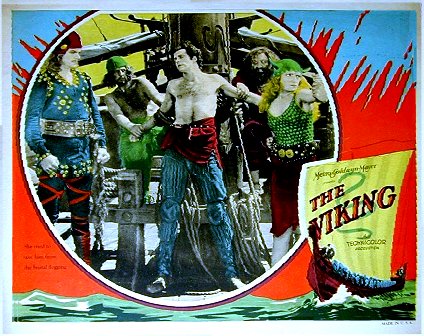
This isn’t exactly a review, because I try to limit reviews, as such, to things our readers can actually buy or rent. The only place I know of where you can access the 1928 movie, The Viking, is on the web site where the friend who lent me the DVD he’d burned found it—and I won’t link to that site because it’s, frankly, mostly porn.
The Viking isn’t porn, though. What it is, is an interesting artifact of movie history—if I understand it right (the explanations on web sites are a little confusing), the first full technicolor movie with a sound track. Mind you, it’s not a dialogue sound track. Just music—the old black dialogue cards tell you what people are saying. Although MGM distributed it, it was actually made by the Technicolor Company, in order to demonstrate their new process (did you know there was technicolor before there were talkies? I didn’t). The color process hasn’t been perfected yet—the yellows and greens aren’t right—but it must have been pretty impressive at the time.
The story is about Leif Eriksson (spelled Ericsson here), very loosely based on the Icelandic Vinland sagas. Leif (played by Donald Crisp, who would eventually become one of Hollywood’s most successful and long-lived character actors) seems to be the lead character, although (somewhat awkwardly for the plot) he doesn’t get the girl.
The movie starts with an attack on a British castle, whose young lord, Alwin (LeRoy Mason), is taken away to slavery in Norway. There he is purchased by a headstrong young woman, Helga (played by Pauline Starke with the kind of arm-waving and back-arching that signified Flaming Youth in the 1920s, though I have to admit she’s kind of cute). Both Leif Ericsson and Leif’s sailing master, Egil (Harry Lewis Woods), are in love with Helga, but Alwin soon has eyes for her too. He’s a stubborn and unruly slave, and only Leif’s timely arrival prevents him being whipped (Leif magnanimously—though unconvincingly from a historical point of view—praises his intelligence and manly spirit, something no real Viking would have tolerated in a slave).
Helga gives Alwin to Leif, and they all set off for Leif’s home in Greenland, Leif having been charged by King Olaf Trygvesson with bringing the gospel to that country. Leif’s father Eric the Red (an oddly clean-shaven Anders Randolph) is happy to welcome his son home, until he finds out Leif has become a Christian, at which point he tries to kill him, and Leif and his crew barely get away with their lives.
Then follows a voyage to Vinland patterned more on Columbus’s than on Leif’s real one. There’s lots of business about the men being afraid of sailing off the edge of the world, and trying to mutiny (something that doesn’t happen at all in the sagas), and no mention at all of Leif’s earlier landfalls in Helluland and Markland. There’s also the love quadrangle business, which goes fairly predictably.
When I told my Facebook friends I’d seen the movie, I gave it a 2 out of 10 in terms of authenticity. Thinking it over, I’ve decided that was over-generous. The only authentic elements I can think of are the fact that Alwin gets his hair cut short when he’s enslaved (though that was surely done to make him look more romantic to 1928 ladies), and the appearance of Leif’s ship. But even that appearance is only true from a distance. The on-board scenes give the ship big cabins fore and aft, which Viking ships never had.
The chief sin of this movie is horned helmets. If you long for Vikings in horned helmets, this is the film for you. And pretty silly they look, too. What’s even odder is that the Vikings seem to wear their helmets like gentlemen’s hats—they have different styles for different occasions. I think Leif has three to choose from.
Helga tends to run around in armor reminiscent of Brunhilde costumes in Wagnerian opera. I think that here we have an early example of the “sexy armor” so popular with fantasy fans today (“sexy armor” is by definition useless for its actual purpose). She doesn’t wear armor all the time, but whatever she wears is appallingly inauthentic, even by the standards of historians of that time.
The Vikings tend to go to war in furs, with horned helmets on their heads, as you’d expect in this sort of thing. The furs seem to be reserved for war, though—they wear more conventional tunics for everyday use.
The swords are very bad, being shaped wrong and having no fullers. The shields are awful, made of metal and bowl-shaped. Even the jewelry isn’t authentic.
No effort whatever was made for historical authenticity, as far as I can see.
The Viking is significant in film history, and good for a laugh. Worth watching just to see how much things have changed, and then never watching again.

I did notice this movie once on Turner Classic Movies, so it may be show again.